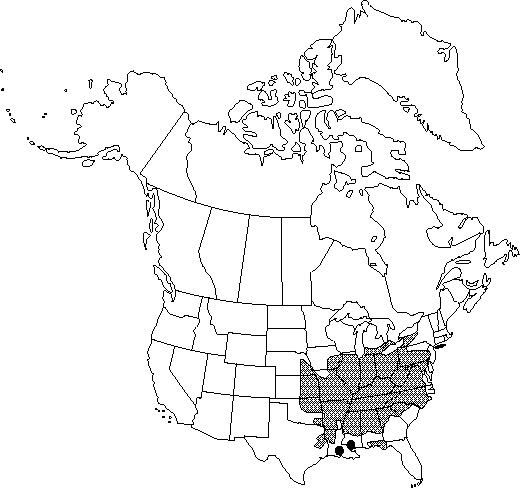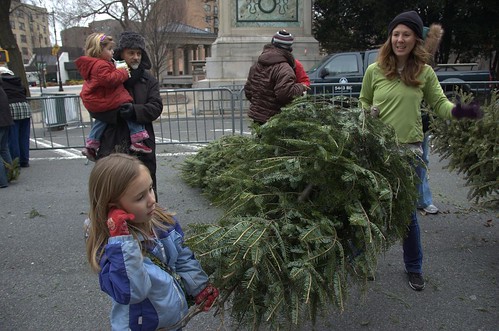2010.08.30: Added information about BBG’s 2010 Signature Plants source, Blossom Nursery.
2010.02.08: More on the Staten Island Pawpaws.
Asimina triloba, Common Pawpaw, is a native fruit true in the Annonaceae, the Custard-Apple Family. The Pawpaw fruit can be up to 12cm/5″ long, the largest fruit native to the U.S. Its taste is likened to a combination of banana and mango, or papaya. Two plants are needed for pollination.
Photo: Scott Bauer, USDA.

Pawpaw is the common name for plants in the genus Asimina, with several species native to eastern North America. A. triloba has the most northern range by far of the genus, reaching into New York, and even southern Ontario, and west to Nebraska. This wide range is attributed to cultivation and distribution by Native American people, including the Cherokee and Iroquois.
Asimina triloba Distribution Map. Credit: eFloras, Flora of North America

Locally, its status is threatened in New York, and endangered in New Jersey. It’s hard to tell from the NY map, but it has been found on Staten Island, New York City. More on this below.
New York counties distribution map. Credit: USDA PLANTS

Pawpaw grows as a large shrub or small understory tree, maturing to about 25′ tall in 20 years, rarely to 30-40′. Pawpaw is prone to spreading by suckering, sending up new stems and trunks from the roots, to form a thicket. This tendency decreases as the plant ages, so removing the suckers while the plant is young will promote a single trunk.
Leaves turn yellow in the fall, but don’t last long.
This is the exclusive food plant for the Zebra Swallowtail, Eurytides marcellus, butterfly. The caterpillars eat the leaves and form cocoons on the tree. Plant a tree, grow butterflies! It’s also the larval host for the Pawpaw sphinx moth, Dolba hyloeus.
I’ve had this post in draft for over a year. This year, the Brooklyn Botanic Garden offers Pawpaw among its Signature Plant selections, prompting me to dust this off and publish it. Here’s what they say about it:
Though native to the eastern U.S., this smallish tree’s luxuriant large green leaves add a tropical appearance to the landscape in summer and turn an attractive yellow in fall as the plump, kidney-shaped edible fruit ripen. Interesting-looking purplish flowers form at leaf axils before the leaves emerge in spring. Given ample sunlight, the tree will grow in a pyramidal shape; in the understory, it is multistemmed and tends to sucker. Pawpaw prefers moist but well-drained fertile soils. Two trees come with this offering to assure pollination for fruit set.
I’ve already started asking my closest neighbors to adopt a Pawpaw!
Blossom Nursery
Since it’s so unusual in commerce, I was curious about the source of the plants. I contacted BBG, and they got a reply from their source, Mark Blossom of Blossom Nursery:
Those Pawpaw trees were grown from seed which were collected in the
Regional Variety Trials Orchard at Kentucky State University, Frankfurt. They have as female parent one of the named cultivars in that collection.
I believe that they are likely to do well in NY, since the Pawpaw cultivars in that collection mostly originated in the North East, and from Maryland to Ohio.
These are the trees which I offer as “Superior Seedlings.”
The Staten Island Pawpaws
I noted in the NY County distribution map above that Pawpaws can be found in Staten Island. (For my non-NYC readers, Staten Island, aka Richmond County, is one of the five boroughs, or counties, of New York City.) Mariellé Anzelone, Executive Director and Founder of NYC Wildflower Week, alerted me in a tweet that the population on Staten Island is “from a historical planting.” That got me curious to know more, and we followed up by email:
A. triloba is more a native to the midwest. As such it’s found rarely in western NY state. It isn’t native to the rest of the state. The population in Staten Island is horticultural. Apparently sometime in the early 1900s the property owner was sent seed from relatives in Indiana. This is the resultant colony and it seems to be doing well. It does produce fruit. It’s a resident in the forest – it’s found on a rolling slope that leads out to a freshwater wetland close to the South Shore.
A 1992 article in the Bulletin of the Torrey Botanical Club described the population.
[bit.ly]
Links
Wikipedia: Asimina triloba, Pawpaw, Annonaceae
NYMF: New York Metropolitan Flora Project, Brooklyn Botanic Garden
eFlora: Flora of North America
FLORI
PFAF
MOBOT
NPIN
PLANTS
UCONN, University of Connecticut Plant Database
Superior Seedlings, Blossom Nursery
Pawpaw Program, Kentucky State University
Pomper, K.W., D.R. Layne, and R.N. Peterson. 1999. The pawpaw regional variety trial. p. 353–357. In: J. Janick (ed.), Perspectives on new crops and new uses. ASHS Press, Alexandria, VA.















